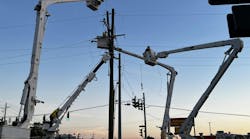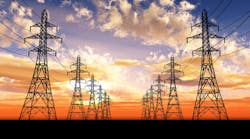Steve Skinner has always been learning. From when he went to work for Idaho Power in the substation construction department as a helper to eventually moving into the utility’s substation engineering group, he has learned everything he can about substations.
When he started out one step below apprentice in 1977, Skinner’s goal was to be a lineman, but “when I found out how much fun it is to build substations, I was hooked,” he said.
During his first couple of years at Idaho Power, he worked on crews that erected the equipment in the substation yard, including 345 kV/230 kV transformers, 345 kV SF6 breakers, 230 kV and 138 kV oil breakers, the substation bus and all associated structures. From there, he spent three years on “wiring crews” where they wired the control panels, installed the cabling, “checked out” all of the wiring, and commissioned the stations being built.
He then moved to one of Idaho Power’s operating regions for seven years, which oversees the operation, troubleshooting, testing, and maintenance of all of the station equipment in that region.
Then in 1989, he moved into Idaho Power Co.’s Substation Engineering Group as an Engineering Support Specialist. The purpose of this job is to help any, and all, of the substation O&M crews with issues that may arise in the course of their “day to day” jobs that they don’t feel comfortable handling.
“I feel that it is better to support these people ‘on the job.’ This gives me the opportunity to work with the technicians in the field and to stay in touch with my roots,” Skinner said.
When he is not in the field, he performs the various office tasks required, including analyzing equipment purchase specifications and bids from the vendors, serving as an on-site project leader, analyzing equipment failures, and teaching Substation Apprentice Classes.
“There is never a dull moment, and the situation is always changing. It must suit me because I have been doing it for more than 25 years and I still love it,” Skinner said.
Skinner will be presenting Challenging Accepted Failure Modes – What Really Happens at the Doble Circuit Breaker Test & Maintenance Training Conference on Oct. 8 in Pittsburgh, Pennsylvania. The session will cover what the “coil current signature” really means.
“By introducing various anomalies into a trip/close coil mechanical system we will determine how each will affect the coil current signature,” Skinner said.
T&D World also interviewed Skinner about his experiences and what he will bring to presenting a session at the Doble conference:
Q: How does your current position help you to present this course dealing with substation operations and maintenance?
My current position is “flying at a higher level” than the O&M people have a chance to do. I often get a chance to present projects to management and other people in the company. I no longer have the fear of presenting.
I get to look at situation “from afar” as opposed to “being in the middle of the storm.”
Because of my position, I get a chance to analyze what is happening. This, coupled with the fact that I have actually been there, gives me the opportunity to present relatively complicated subjects in words that people can understand. I also have some good stories to tell, having been in their shoes, to help illustrate the subject.
Q: When did you decide to go into your particular career field?
I didn’t consciously decide to go into this field! I just stumbled into it and then realized how much fun it is!
When I started with Idaho Power Co., I had my mind set on being a lineman. The job was performing before Idaho Power was working for a company that trimmed trees around power lines. I knew how to climb, operate man lifts, and work around energized power lines……lineman, right?
Idaho Power Co. was building their 345 kV system, lines and substations, when I was hired. It takes more people to build a substation than it does a line. The opening was in the substation group; I accepted it and found how much more fun substations are than lines. I was hooked.
Q: The best thing about your job?
It is difficult to separate out just one. I love to learn and I like to teach. My job now offers me the chance to do both. Every situation that I encounter as a support person gives me a chance to learn something: something completely new or something I know but am required to think about in a different way. Many times I have the chance to teach the technicians what I’ve learned while I’m standing right next to them in a substation.
Q: What other experiences do you have presenting courses?
I have presented, or co-presented a variety of topics at The Doble Spring Conference, IEEE conferences, The Doble Circuit Breaker Conference, and I teach a “Circuit Breaker Class” as part of Idaho Power Co.’s Apprentice training program.
Q: What is the most important thing you have learned from your past experiences?
Substation equipment and substations in general, are complicated. It takes “smart guys” to build, operate, and maintain them. The difference between “the smart guys” and those of us who “aren’t so smart” is a bunch of years of experience and study, and they are interested. The really cool thing is that most of those “smart guys” will spend lots of time and effort teaching those of us “who aren’t so smart”, if we show that we are truly interested.
Q: Why is this course on Challenging Accepted Failure Modes important?
Over the years, substation O&M has made a shift from “tear down” maintenance to “condition based maintenance.” This requires the technicians to truly understand the results they are receiving from the test equipment.
Many of us have just accepted the information received about “coil current signatures” as gospel. With this data it will be possible to actually see what the changes are in the coil current signature as various situations are introduced into the coil assembly.
Q: How do you spend your spare time and does it benefit you in your professional life?
In the summer, I like to fly fish the mountain lakes in Idaho from a float tube, and help my grandson build his ’77 “short bed step side pickup” into a drag racer.
In the winter I snow ski, alpine, not cross country…..that’s too damn much work.
Fly fishing teaches patience and analytics, both necessary skills in substations. However, trout live in much prettier places that substations do.
Drag racing is all about mechanics, physics, and technique. It’s loud, fast, and somewhat dangerous. It teaches you to keep your cool when things are flying apart. Just like substations.
Downhill snow skiing is pretty much an escape. When I am skiing, I only think about the hill. But I guess it is an extension as well. My method of problem solving is, “Think about the problem as hard as you can, for as long as you can. If the solution doesn’t come, stop thinking about it. While your mind is clear, the answer appears…..as if by magic.


